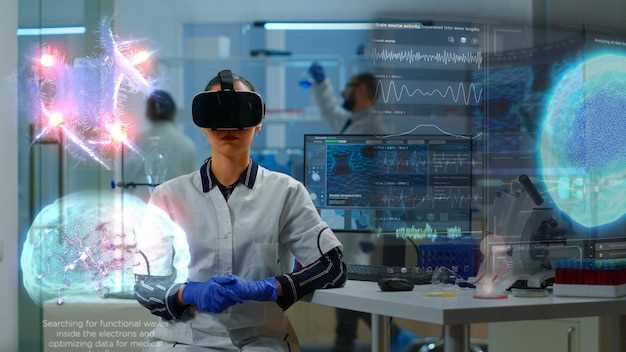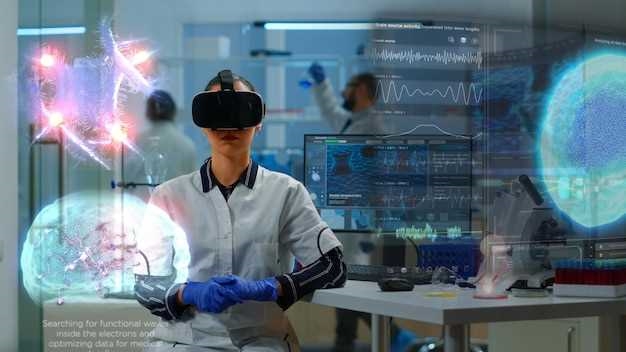
With the rapid advancements in science and technology, the landscape of healthcare is undergoing a remarkable metamorphosis. In recent years, a wave of innovative solutions has emerged, reshaping the way we approach medical care and revolutionizing the very essence of the industry. These groundbreaking developments, driven by a fusion of creativity and scientific prowess, are propelling us into an era where the boundaries of what is possible in healthcare are being pushed to unprecedented limits.
At the forefront of this transformative movement are ingenious health tech pioneers who are harnessing the power of state-of-the-art technologies to enhance patient outcomes, improve diagnostics, and streamline healthcare delivery. Through the ingenious application of cutting-edge tools and methodologies, these visionaries are ushering in a new era of personalized medicine, where treatments are tailored to the unique needs of each individual, and the potential for early detection and prevention of diseases is maximized.
One of the most remarkable aspects of these health tech innovations is their ability to seamlessly integrate into our daily lives, empowering individuals to take control of their own health and well-being. From wearable devices that monitor vital signs and track fitness goals to mobile applications that provide instant access to medical information and telemedicine services, technology is bridging the gap between patients and healthcare providers, making healthcare more accessible, efficient, and patient-centric than ever before.
Moreover, these advancements are not limited to the realm of patient care alone. The healthcare industry as a whole is benefiting from the transformative power of technology. From data analytics and artificial intelligence to robotic surgery and virtual reality training, the potential for improving operational efficiency, reducing costs, and enhancing the overall quality of care is immense. As we embrace these technological marvels, we are witnessing a paradigm shift in healthcare, where the focus is shifting from reactive treatment to proactive prevention, from fragmented care to integrated systems, and from traditional practices to a future that is driven by data-driven insights and innovation.
Artificial Intelligence in Diagnostics: Transforming Healthcare Diagnosis
Advancements in the field of artificial intelligence have brought about a paradigm shift in healthcare diagnosis. By harnessing the power of intelligent algorithms and machine learning, medical professionals are now able to leverage cutting-edge technology to enhance the accuracy and efficiency of diagnostic processes.
Revolutionizing Medical Decision-Making

Artificial intelligence has revolutionized medical decision-making by providing healthcare practitioners with invaluable insights and support. Through the analysis of vast amounts of medical data, AI algorithms can identify patterns, detect anomalies, and predict potential outcomes with a level of precision that surpasses human capabilities. This enables doctors to make more informed decisions, leading to improved patient outcomes and personalized treatment plans.
Enhancing Diagnostic Accuracy
One of the key benefits of incorporating artificial intelligence into diagnostics is its ability to enhance diagnostic accuracy. AI-powered systems can analyze medical images, such as X-rays, CT scans, and MRIs, with remarkable precision, detecting even the smallest abnormalities that may go unnoticed by human eyes. By minimizing the risk of misdiagnosis and enabling early detection of diseases, AI technology plays a crucial role in improving patient care and saving lives.
Wearable Devices: Empowering Individuals to Take Control of Their Health
In today’s rapidly evolving world, individuals are increasingly seeking ways to actively manage and improve their well-being. Wearable devices have emerged as a game-changing solution, empowering individuals to take control of their health like never before.
Enhancing Self-Awareness
Wearable devices provide individuals with real-time insights into their physical activity, sleep patterns, and overall health. By tracking metrics such as steps taken, calories burned, and heart rate, these devices offer a comprehensive view of one’s daily habits and behaviors. This newfound self-awareness enables individuals to make informed decisions and take proactive steps towards a healthier lifestyle.
Personalized Health Monitoring
With wearable devices, individuals can now monitor their health in a personalized and convenient manner. These devices can track vital signs, such as blood pressure, blood glucose levels, and oxygen saturation, allowing individuals to keep a close eye on their well-being. By having access to this valuable information at their fingertips, individuals can detect potential health issues early on and seek appropriate medical attention, leading to better health outcomes.
Furthermore, wearable devices can also provide reminders and alerts for medication intake, hydration, and exercise, ensuring individuals stay on track with their health goals. This personalized approach to health monitoring empowers individuals to actively participate in their own care and make proactive choices for their well-being.
In conclusion, wearable devices have revolutionized the way individuals manage their health. By enhancing self-awareness and offering personalized health monitoring, these devices empower individuals to take control of their well-being and make informed decisions for a healthier future.
Telemedicine: Breaking Barriers to Accessible Healthcare
In today’s rapidly evolving world, the field of telemedicine is revolutionizing the way healthcare is accessed and delivered. By leveraging technology, telemedicine is breaking down barriers and providing individuals with convenient and accessible healthcare services.
Enhancing Accessibility
Telemedicine is bridging the gap between patients and healthcare providers, eliminating the need for physical visits to clinics or hospitals. Through the use of video consultations, patients can now receive medical advice and treatment from the comfort of their own homes, regardless of their geographical location. This not only saves time and money but also ensures that individuals in remote or underserved areas have access to quality healthcare.
Improving Efficiency
With telemedicine, healthcare providers can efficiently manage their patient load and reduce waiting times. By offering virtual appointments, doctors can see more patients in a day, leading to improved efficiency in healthcare delivery. Additionally, telemedicine allows for the seamless sharing of medical records and test results, enabling healthcare professionals to make informed decisions and provide accurate diagnoses and treatment plans.
- Increased convenience for patients
- Reduced healthcare costs
- Improved patient outcomes
- Enhanced collaboration between healthcare professionals
- Expanded access to specialized care
Telemedicine is transforming the healthcare landscape, making it more accessible and convenient for individuals to receive the care they need. By breaking down geographical barriers and leveraging technology, telemedicine is revolutionizing healthcare delivery and improving patient outcomes.
Robotics in Surgery: Advancing Precision and Efficiency
Advancements in the field of surgical robotics have brought about a significant transformation in the way surgeries are performed. These cutting-edge technologies have revolutionized the precision and efficiency of surgical procedures, leading to improved patient outcomes and reduced recovery times.
Enhancing Precision through Robotics
Robotic systems in surgery offer unparalleled precision, allowing surgeons to perform complex procedures with utmost accuracy. The use of robotic arms equipped with advanced sensors and imaging technology enables surgeons to visualize the surgical site in real-time, providing a detailed view of the patient’s anatomy. This enhanced visualization aids in precise incisions, tissue manipulation, and suturing, minimizing the risk of errors and complications.
Improving Efficiency in Surgical Procedures

Robotics in surgery also plays a crucial role in enhancing the efficiency of surgical procedures. With the assistance of robotic systems, surgeons can perform tasks with greater dexterity and control, even in confined spaces. The robotic arms can be programmed to mimic the movements of the surgeon’s hand, allowing for precise and delicate maneuvers. Additionally, robotic systems can automate certain aspects of the surgery, reducing the time required for specific tasks and enabling surgeons to focus on critical decision-making.
In conclusion, the integration of robotics in surgery has revolutionized the healthcare industry by advancing precision and efficiency in surgical procedures. These technological advancements have paved the way for improved patient outcomes, reduced complications, and enhanced surgical capabilities. As the field continues to evolve, the potential for further innovations in robotics holds great promise for the future of healthcare.
Virtual Reality in Therapy: Enhancing Rehabilitation and Mental Health Treatment
In the realm of therapeutic interventions, a groundbreaking technology has emerged that holds immense potential for transforming the way rehabilitation and mental health treatment are approached. Virtual reality (VR) has emerged as a powerful tool that can enhance the effectiveness of therapy, providing individuals with immersive and interactive experiences that promote healing and well-being.
VR therapy offers a unique and innovative approach to rehabilitation, allowing patients to engage in simulated environments that replicate real-life situations. By immersing individuals in these virtual environments, therapists can create controlled and customizable scenarios that facilitate the relearning of skills and the development of coping mechanisms. Whether it’s helping stroke survivors regain mobility or assisting individuals with anxiety disorders in confronting their fears, VR therapy offers a safe and controlled space for targeted interventions.
Furthermore, virtual reality has shown promising results in the field of mental health treatment. By creating virtual environments that simulate anxiety-inducing situations, therapists can guide patients through exposure therapy, gradually desensitizing them to their fears and helping them overcome phobias and post-traumatic stress disorders. Additionally, VR therapy has proven effective in treating conditions such as depression and addiction, providing individuals with a sense of presence and immersion that can enhance engagement and motivation in the therapeutic process.
One of the key advantages of VR therapy is its ability to provide immediate feedback and data tracking. Through the use of sensors and motion tracking devices, therapists can monitor patients’ progress in real-time, allowing for personalized and data-driven treatment plans. This technology also enables therapists to adjust the intensity and difficulty of virtual scenarios based on individual needs, ensuring optimal therapeutic outcomes.
In conclusion, virtual reality is revolutionizing the field of therapy by enhancing rehabilitation and mental health treatment. By leveraging the immersive and interactive nature of VR, therapists can create tailored interventions that promote healing, skill development, and emotional well-being. With its ability to simulate real-life situations and provide immediate feedback, VR therapy offers a promising avenue for improving the effectiveness and accessibility of therapeutic interventions.
Blockchain in Healthcare: Securing Patient Data and Streamlining Processes
In the rapidly evolving landscape of healthcare, the integration of blockchain technology has emerged as a game-changer. This innovative approach offers a secure and efficient solution for safeguarding patient data and optimizing various processes within the healthcare industry. By leveraging the power of blockchain, healthcare providers can ensure the privacy and integrity of sensitive information, while also streamlining administrative tasks and enhancing overall patient care.
Enhancing Data Security and Privacy
One of the primary benefits of implementing blockchain in healthcare is the enhanced security and privacy it provides for patient data. Traditional methods of storing and sharing medical records are often vulnerable to breaches and unauthorized access. However, blockchain technology utilizes a decentralized and immutable ledger system, where each transaction is securely recorded and linked to previous transactions. This ensures that patient data remains tamper-proof and transparent, reducing the risk of data breaches and unauthorized alterations.
Furthermore, blockchain enables patients to have greater control over their own data. Through the use of smart contracts, individuals can grant or revoke access to their medical records, ensuring that only authorized healthcare providers can view and update their information. This empowers patients to maintain ownership of their data and make informed decisions regarding its usage.
Streamlining Healthcare Processes
In addition to enhancing data security, blockchain technology also has the potential to streamline various processes within the healthcare industry. The decentralized nature of blockchain eliminates the need for intermediaries, such as insurance companies or third-party administrators, reducing administrative costs and improving efficiency.
For instance, blockchain can simplify the process of insurance claims by automating verification and settlement procedures. Smart contracts can be programmed to automatically execute payments when specific conditions are met, eliminating the need for manual processing and reducing the likelihood of errors or delays.
Moreover, blockchain can facilitate the sharing of medical records and other relevant information between different healthcare providers. This eliminates the need for patients to carry physical copies of their records and allows for seamless collaboration and continuity of care. Healthcare professionals can access a patient’s complete medical history, enabling more accurate diagnoses and personalized treatment plans.
In conclusion, the integration of blockchain technology in healthcare holds immense potential for securing patient data and streamlining various processes. By leveraging the decentralized and transparent nature of blockchain, healthcare providers can ensure the privacy and integrity of sensitive information, while also optimizing administrative tasks and improving overall patient care.
